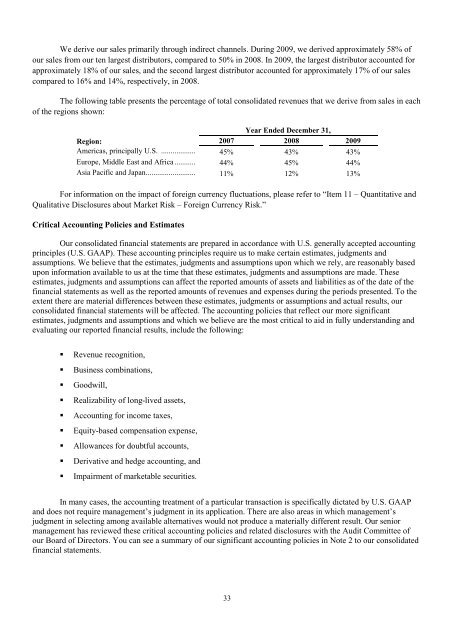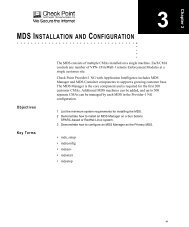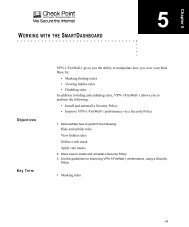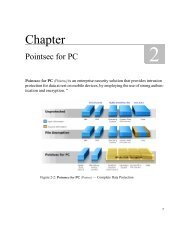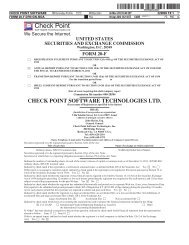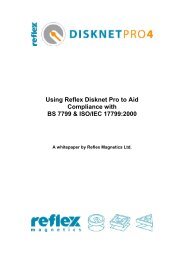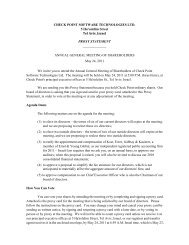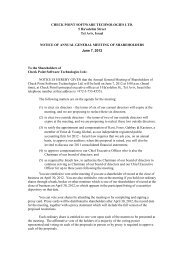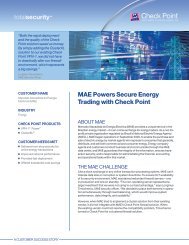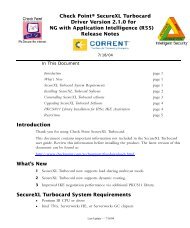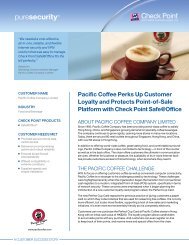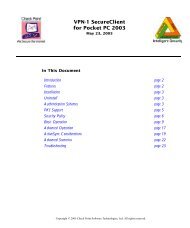FORM 20-F - Check Point
FORM 20-F - Check Point
FORM 20-F - Check Point
You also want an ePaper? Increase the reach of your titles
YUMPU automatically turns print PDFs into web optimized ePapers that Google loves.
We derive our sales primarily through indirect channels. During <strong>20</strong>09, we derived approximately 58% of<br />
our sales from our ten largest distributors, compared to 50% in <strong>20</strong>08. In <strong>20</strong>09, the largest distributor accounted for<br />
approximately 18% of our sales, and the second largest distributor accounted for approximately 17% of our sales<br />
compared to 16% and 14%, respectively, in <strong>20</strong>08.<br />
The following table presents the percentage of total consolidated revenues that we derive from sales in each<br />
of the regions shown:<br />
Region: <strong>20</strong>07<br />
Year Ended December 31,<br />
<strong>20</strong>08 <strong>20</strong>09<br />
Americas, principally U.S. .................. 45% 43% 43%<br />
Europe, Middle East and Africa ........... 44% 45% 44%<br />
Asia Pacific and Japan .......................... 11% 12% 13%<br />
For information on the impact of foreign currency fluctuations, please refer to “Item 11 – Quantitative and<br />
Qualitative Disclosures about Market Risk – Foreign Currency Risk.”<br />
Critical Accounting Policies and Estimates<br />
Our consolidated financial statements are prepared in accordance with U.S. generally accepted accounting<br />
principles (U.S. GAAP). These accounting principles require us to make certain estimates, judgments and<br />
assumptions. We believe that the estimates, judgments and assumptions upon which we rely, are reasonably based<br />
upon information available to us at the time that these estimates, judgments and assumptions are made. These<br />
estimates, judgments and assumptions can affect the reported amounts of assets and liabilities as of the date of the<br />
financial statements as well as the reported amounts of revenues and expenses during the periods presented. To the<br />
extent there are material differences between these estimates, judgments or assumptions and actual results, our<br />
consolidated financial statements will be affected. The accounting policies that reflect our more significant<br />
estimates, judgments and assumptions and which we believe are the most critical to aid in fully understanding and<br />
evaluating our reported financial results, include the following:<br />
� Revenue recognition,<br />
� Business combinations,<br />
� Goodwill,<br />
� Realizability of long-lived assets,<br />
� Accounting for income taxes,<br />
� Equity-based compensation expense,<br />
� Allowances for doubtful accounts,<br />
� Derivative and hedge accounting, and<br />
� Impairment of marketable securities.<br />
In many cases, the accounting treatment of a particular transaction is specifically dictated by U.S. GAAP<br />
and does not require management’s judgment in its application. There are also areas in which management’s<br />
judgment in selecting among available alternatives would not produce a materially different result. Our senior<br />
management has reviewed these critical accounting policies and related disclosures with the Audit Committee of<br />
our Board of Directors. You can see a summary of our significant accounting policies in Note 2 to our consolidated<br />
financial statements.<br />
33


